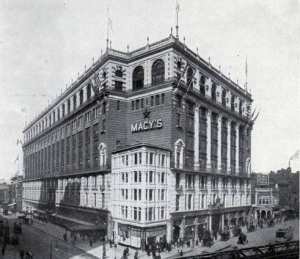After Lord & Taylor opened its new Italian Renaissance–inspired flagship building on Fifth Avenue and 38th Street in February 1914, the legendary department store continued its reputation as a retail pioneer.
The store was built with its own electricity generator and concert hall, and in 1916, the beloved holiday windows made their debut. Later, extra mirrors were added to selling floors and dressing rooms—something now totally standard for a department store—so customers had a better view of themselves and the merchandise.
 But one feature Lord & Taylor installed in the new building was definitely more old school: the in-store tea room.
But one feature Lord & Taylor installed in the new building was definitely more old school: the in-store tea room.
Tea rooms and dining areas could be found in many stores on Ladies Mile—the trapezoid shaped enclave between Broadway and Sixth Avenue and 10th to 23rd Streets where Gilded Age women could shop, mingle, and enjoy each other’s company as they partook in the era’s consumerism. (Lord & Taylor built a magnificent store on this strip in 1870 at Broadway and 20th Street.)
As the city marched northward and department stores like Lord & Taylor relocated to Herald Square and Fifth Avenue, they brought their dining areas and tea rooms with them.
 What’s so special about a department store tea room? It may sound strange to our sensibilities today, but even after the turn of the last century, women didn’t dine alone in restaurants.
What’s so special about a department store tea room? It may sound strange to our sensibilities today, but even after the turn of the last century, women didn’t dine alone in restaurants.
The presence of a solo woman who simply wanted to rest and get a bite to eat after browsing the latest fashions might suggest she had illicit motives for being there.
And she certainly couldn’t sit at a saloon; bars were all-male preserves, and proper women didn’t drink (at least not in public).
But women shoppers needed a place to rest and refuel, especially since shopping had become something of a leisure activity, and it was one of the few activities women could do without being escorted by men.
To fill the void were confectionaries and tea rooms, some of which were inside a department store itself.
These menus from Lord & Taylor’s in-store tea room, from 1914 and 1917, can give you an idea of what (mainly) female shoppers, in groups or on their own, dined on during their shopping trips.
Much of the fare is light, and all of it non-alcoholic. Coup Julia Marlowe sound very early 1900s; she was a famous actress of the time with a spectacular mansion on Riverside Drive.
The tea rooms are gone, as is the 38th Street Lord & Taylor store. This week comes news that the company—which has its roots in a humble dry goods store opened on today’s Lower East Side in 1824—is going out of business for good.
If Lord & Taylor’s time has come, we’ll have to accept it—while remembering that in big and small ways, the store helped shape shopping habits in the late 19th and early 20th city.
[Images: NYPL Digital Collection]








